Smokin Moose
Fallen Cannabis Warrior & Ex Moderator
Harvesting is, without a doubt, the most exciting part of the wonderful journey that is cannabis cultivation. After months of watching, waiting and tending to your plants’ every need, the time is approaching when you must cut them down to harvest their resin-coated buds and all of the leftover trim that can be used to make fresh potent hash.
You know that you need to harvest your plants in the coming weeks, but when exactly is the best time to do it? Every strain of marijuana has its own life cycle, so it’s not as simple as a specific number of weeks after flowering has begun. It’s even more complicated since you can choose when to harvest your crop for bud that provides either a head high or a body stone. Luckily, most if not all strains of commercially grown cannabis provide visual clues on when to harvest, and what type of high you are likely to achieve.
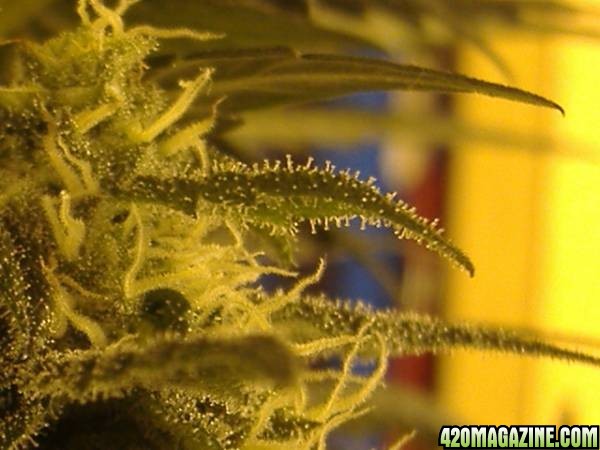
In this article, we’re going to explore the final phase of your plants’ growth cycle: the flowering or budding phase. Specifically, we want to look at the last two weeks of the flowering phase in what is known as the “window of peak maturity”. The window of peak maturity is when trichome development and the level of THC production in your plants have reached their maximum point, which is when you would harvest your plants. By being patient and paying close attention to certain indicators, you can reap fantastic buds that provide you with precisely the type of high that suits you best.
THC and Trichomes
Almost everyone who enjoys marijuana knows that, for whatever reason, THC is the psychoactive component in the bud they ingest.
As a cannabis cultivator, it helps to know just a little bit more than what THC is—such as how it develops over time and how chemical changes in trichomes contribute to different psychoactive effects.
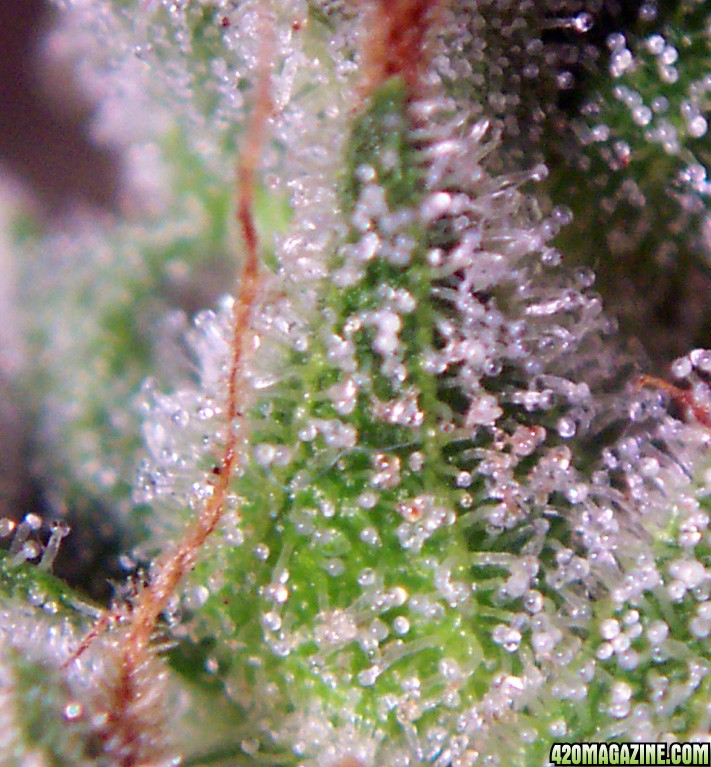
The primary goal of any plant is to create and nurture seeds to be viable for future growth. Trichomes help prevent seed damage from insects, animals, light degradation and fungal disease. In the case of cannabis, trichomes also contain THC, the chemical compound that provides a psychedelic high to humans. THC stands for Tetrahydrocannabinol (C21H30O2). Near the end of the flowering cycle, THC begins to break down and turns into another chemical compound called Cannabinol, or CBN (C21H26O2), in a process known as oxidization. Higher levels of CBN tend to provide a more narcotic or “stoned” feeling, while THC delivers a more euphoric, upbeat “high”. Knowing this, you can examine the trichomes and the pistils of the plant, then choose when you harvest to get the psychoactive effects you desire.
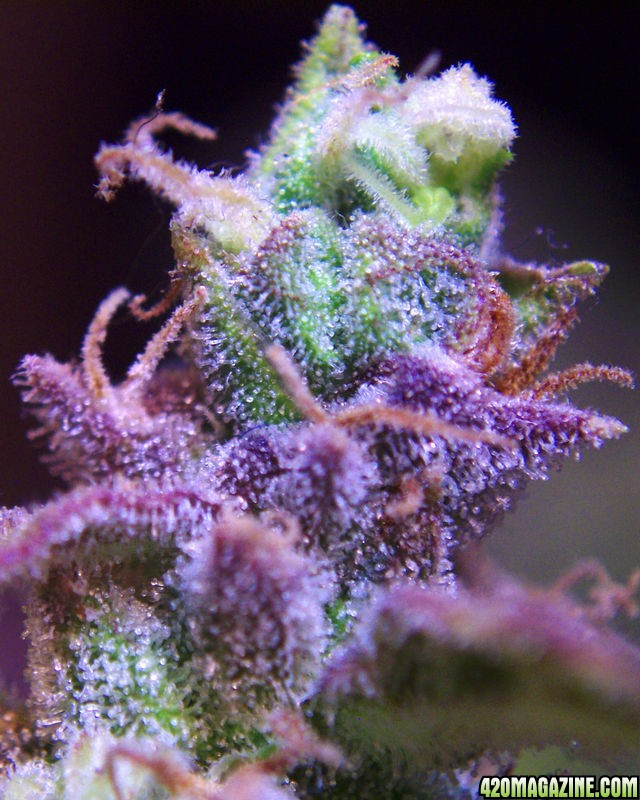
Cannabis plants produce THC and CBN on their stems, leaves, and vegetation surrounding the buds and are developed in trichomes, which emerge on the surface of most of the plant’s parts. On the stems and the early fan leaves, the trichomes are small and hug the surface. As the flowering phase continues, the glands develop on the more mature parts of the plant, including the smaller leaves and the first calyxes (which exist to develop and nurture seeds if male pollen fertilizes the female plant). The trichomes that develop on calyxes no longer hug the plant’s surface, but are on stalks like mushrooms with bulbous caps. During this time, more and more trichome-covered calyxes develop and create densely packed clusters, called ‘bud’. As your plants enter the final stages of their life cycle, the calyxes begin to swell and ripen, while more and more resin glands develop on the surface.
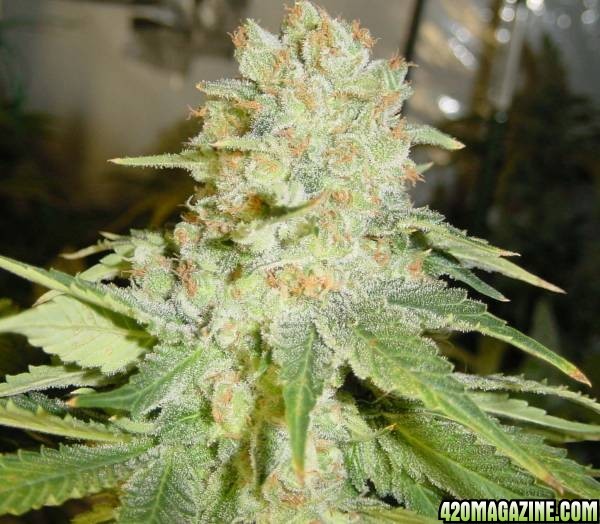
Another indication of plant maturity is the color of the pistils, the little hairs that grow from inside the calyxes. Their purpose is to collect male pollen to fertilize the ovum inside the calyx, creating a seed. When no male pollen exists calyxes grow dense without any seeds, resulting in sinsemilla cannabis. Near the end of the flowering phase, pistils change color, entering the window of peak maturity. The ratio of white pistils to red pistils determines the type of effects your plants are likely to produce: a high or stone. In the final few weeks of the flowering phase, the pistils change from bright white to a rusty orange or brown, signifying the end of the plant’s life cycle.
Examining Trichomes

As the amount of trichomes covering your plant increases, you should take a closer look at them, maintaining a light touch to avoid crushing the resin glands. Your best bet is to purchase an inexpensive 25x microscope (available at most electronics stores), and most pocket microscopes have a small light to help you get an illuminated peek at your trichome development.
When you cut small buds from your plant to test them, you want to concentrate on the stalked glandular trichomes. The coloration of the gland heads can vary with different strains and maturity, but most start with clear or slightly amber heads that gradually become cloudy or opaque when THC levels have peaked and are beginning to degrade. Regardless of the initial color of the trichomes, with careful observation you should be able to see a change in coloration as maturity levels off. Some cultivators wait for about half of the trichomes to go opaque before harvesting to ensure maximum THC levels in the finished product. However, you will also want to try samples at various stages to see what is best for you. While you may be increasing the total THC level in the cannabis by allowing half of the glands to go opaque, there will also be a larger percentage of CBN, which is why some people choose to harvest earlier while most of the trichomes are still clear.
Now you understand how trichomes develop on your plants and how to examine them as they turn from clear to opaque, indicating THC breakdown.
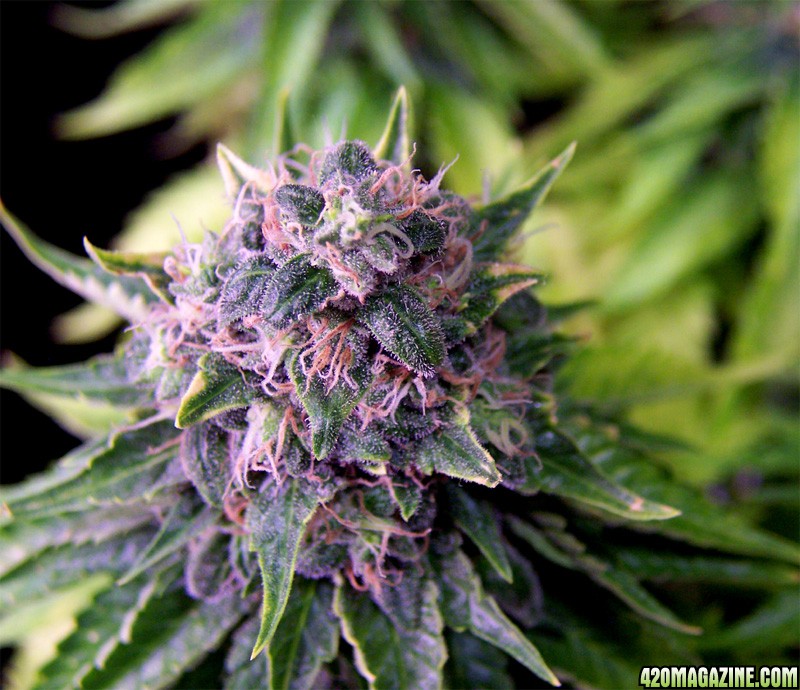
Early and Late Harvesting
Every strain has its own unique window of peak maturity, typically one to two weeks long. However, there is a difference between har vesting early or late within that window, depending on whether you want a head high or a body high.
As cannabis matures the chemistry of the plant changes, as does the type of effects. While these differences in chemical nature still require a lot of research to fully understand, you can utilize them to produce different types of highs for different needs.
By harvesting earlier in the window your buds tend to produce more of a cerebral head high, an effect much more pronounced in Sativas than Indicas. A head high is more psychedelic in nature, providing you with a pleasant mental “up” state, often ideally suited for social situations when you still need to have your wits and plenty of energy.
If you choose to harvest later in the window, your buds produce more of a body high, which is conversely more pronounced in Indicas than in Sativas. A body high is similar to a narcotic “down” effect, usually associated with being “stoned”. A down type of high is often desired in the late evening to calm nerves and drift into sleep. A late-harvest yield is often sought by medicinal cannabis users to ease pain and increase appetite. If you choose to harvest somewhere in the middle of the peak window of maturity, you don’t necessarily get the best of both worlds, but more of a happy medium. If you aren’t sure what type of high you like or want, aim for the middle and you likely won’t be disappointed.
As you continue to examine your plants, you will be tempted, even compelled, to start pulling buds off of your plants to test them out. There is a right way and a wrong way to try out your buds before they are ready, so let’s take a look at your options.
Testing Your Buds
Most new growers start picking at their crop only a few weeks after budding starts. Usually this is because inexperienced growers get too excited and they don’t know that these small, immature buds still have a way to go before they hit peak maturity and reach the highest trichome development. But there is definitely nothing wrong with being excited about your ladies! Even veteran growers still get giddy seeing their plants start to sag under the weight of so much resin.
I don’t recommend taking any buds from your plants until they are approaching their window of harvest, and you should only take a small bud every day or two. You can test your first bud when approximately 10% of the pistils have turned reddishbrown; take it from the middle area of the plant. Once you’ve cut your self a small bud to try out, you need to dry it, but drying and curing traditionally takes longer than the entire window of peak maturity, so you have to quick dry it. Quick drying is a sub-optimal way to turn a lush, wet bud into something you can smoke, but it’s the best way to quickly test your bud every other day as it matures.
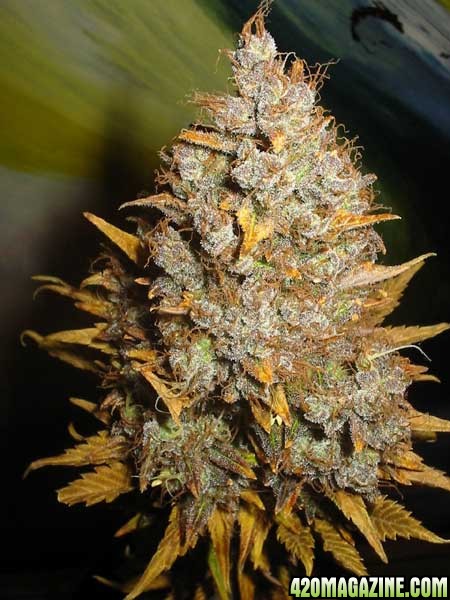
There are lots of different ways to quick dry your bud, but one of the best ways is to use your lighting ballasts in the grow room. First, cut up your fresh bud and spread it out evenly in an envelope. Close the envelope and place it on top of your ballast, then leave it there for two to three hours while the light is on. After the buds are dried out, put them in an airtight container and allow the last of the moisture to move from the stem into the bud. Considering this is a quick dry method, the taste is usually good and the potency is acceptable. Also, the use of a vaporizer will allow you to concentrate on your high rather than being distracted by the odd taste of quick-dried weed smoke.
By now you know what trichomes are and how the chemicals in them evolve from producing a head high to a body high over a couple of weeks. You also know that the pistils on your buds change color from white to reddish-brown as the window of harvest opens and closes, as well as what type of high to expect depending on the percentage of new and mature pistils. Throughout the window of harvest, you took small buds from the middle of the plant, quick dried them, then tested them out to determine the type of high you want your crop to give you. Now, you can harvest your plants with confidence in knowing that they will be loaded with resin that produces just the right kind of high you were looking for. Enjoy your harvest!
You know that you need to harvest your plants in the coming weeks, but when exactly is the best time to do it? Every strain of marijuana has its own life cycle, so it’s not as simple as a specific number of weeks after flowering has begun. It’s even more complicated since you can choose when to harvest your crop for bud that provides either a head high or a body stone. Luckily, most if not all strains of commercially grown cannabis provide visual clues on when to harvest, and what type of high you are likely to achieve.

In this article, we’re going to explore the final phase of your plants’ growth cycle: the flowering or budding phase. Specifically, we want to look at the last two weeks of the flowering phase in what is known as the “window of peak maturity”. The window of peak maturity is when trichome development and the level of THC production in your plants have reached their maximum point, which is when you would harvest your plants. By being patient and paying close attention to certain indicators, you can reap fantastic buds that provide you with precisely the type of high that suits you best.
THC and Trichomes
Almost everyone who enjoys marijuana knows that, for whatever reason, THC is the psychoactive component in the bud they ingest.
As a cannabis cultivator, it helps to know just a little bit more than what THC is—such as how it develops over time and how chemical changes in trichomes contribute to different psychoactive effects.

The primary goal of any plant is to create and nurture seeds to be viable for future growth. Trichomes help prevent seed damage from insects, animals, light degradation and fungal disease. In the case of cannabis, trichomes also contain THC, the chemical compound that provides a psychedelic high to humans. THC stands for Tetrahydrocannabinol (C21H30O2). Near the end of the flowering cycle, THC begins to break down and turns into another chemical compound called Cannabinol, or CBN (C21H26O2), in a process known as oxidization. Higher levels of CBN tend to provide a more narcotic or “stoned” feeling, while THC delivers a more euphoric, upbeat “high”. Knowing this, you can examine the trichomes and the pistils of the plant, then choose when you harvest to get the psychoactive effects you desire.

Cannabis plants produce THC and CBN on their stems, leaves, and vegetation surrounding the buds and are developed in trichomes, which emerge on the surface of most of the plant’s parts. On the stems and the early fan leaves, the trichomes are small and hug the surface. As the flowering phase continues, the glands develop on the more mature parts of the plant, including the smaller leaves and the first calyxes (which exist to develop and nurture seeds if male pollen fertilizes the female plant). The trichomes that develop on calyxes no longer hug the plant’s surface, but are on stalks like mushrooms with bulbous caps. During this time, more and more trichome-covered calyxes develop and create densely packed clusters, called ‘bud’. As your plants enter the final stages of their life cycle, the calyxes begin to swell and ripen, while more and more resin glands develop on the surface.

Another indication of plant maturity is the color of the pistils, the little hairs that grow from inside the calyxes. Their purpose is to collect male pollen to fertilize the ovum inside the calyx, creating a seed. When no male pollen exists calyxes grow dense without any seeds, resulting in sinsemilla cannabis. Near the end of the flowering phase, pistils change color, entering the window of peak maturity. The ratio of white pistils to red pistils determines the type of effects your plants are likely to produce: a high or stone. In the final few weeks of the flowering phase, the pistils change from bright white to a rusty orange or brown, signifying the end of the plant’s life cycle.
Examining Trichomes

As the amount of trichomes covering your plant increases, you should take a closer look at them, maintaining a light touch to avoid crushing the resin glands. Your best bet is to purchase an inexpensive 25x microscope (available at most electronics stores), and most pocket microscopes have a small light to help you get an illuminated peek at your trichome development.
When you cut small buds from your plant to test them, you want to concentrate on the stalked glandular trichomes. The coloration of the gland heads can vary with different strains and maturity, but most start with clear or slightly amber heads that gradually become cloudy or opaque when THC levels have peaked and are beginning to degrade. Regardless of the initial color of the trichomes, with careful observation you should be able to see a change in coloration as maturity levels off. Some cultivators wait for about half of the trichomes to go opaque before harvesting to ensure maximum THC levels in the finished product. However, you will also want to try samples at various stages to see what is best for you. While you may be increasing the total THC level in the cannabis by allowing half of the glands to go opaque, there will also be a larger percentage of CBN, which is why some people choose to harvest earlier while most of the trichomes are still clear.
Now you understand how trichomes develop on your plants and how to examine them as they turn from clear to opaque, indicating THC breakdown.

Early and Late Harvesting
Every strain has its own unique window of peak maturity, typically one to two weeks long. However, there is a difference between har vesting early or late within that window, depending on whether you want a head high or a body high.
As cannabis matures the chemistry of the plant changes, as does the type of effects. While these differences in chemical nature still require a lot of research to fully understand, you can utilize them to produce different types of highs for different needs.
By harvesting earlier in the window your buds tend to produce more of a cerebral head high, an effect much more pronounced in Sativas than Indicas. A head high is more psychedelic in nature, providing you with a pleasant mental “up” state, often ideally suited for social situations when you still need to have your wits and plenty of energy.
If you choose to harvest later in the window, your buds produce more of a body high, which is conversely more pronounced in Indicas than in Sativas. A body high is similar to a narcotic “down” effect, usually associated with being “stoned”. A down type of high is often desired in the late evening to calm nerves and drift into sleep. A late-harvest yield is often sought by medicinal cannabis users to ease pain and increase appetite. If you choose to harvest somewhere in the middle of the peak window of maturity, you don’t necessarily get the best of both worlds, but more of a happy medium. If you aren’t sure what type of high you like or want, aim for the middle and you likely won’t be disappointed.
As you continue to examine your plants, you will be tempted, even compelled, to start pulling buds off of your plants to test them out. There is a right way and a wrong way to try out your buds before they are ready, so let’s take a look at your options.
Testing Your Buds
Most new growers start picking at their crop only a few weeks after budding starts. Usually this is because inexperienced growers get too excited and they don’t know that these small, immature buds still have a way to go before they hit peak maturity and reach the highest trichome development. But there is definitely nothing wrong with being excited about your ladies! Even veteran growers still get giddy seeing their plants start to sag under the weight of so much resin.
I don’t recommend taking any buds from your plants until they are approaching their window of harvest, and you should only take a small bud every day or two. You can test your first bud when approximately 10% of the pistils have turned reddishbrown; take it from the middle area of the plant. Once you’ve cut your self a small bud to try out, you need to dry it, but drying and curing traditionally takes longer than the entire window of peak maturity, so you have to quick dry it. Quick drying is a sub-optimal way to turn a lush, wet bud into something you can smoke, but it’s the best way to quickly test your bud every other day as it matures.

There are lots of different ways to quick dry your bud, but one of the best ways is to use your lighting ballasts in the grow room. First, cut up your fresh bud and spread it out evenly in an envelope. Close the envelope and place it on top of your ballast, then leave it there for two to three hours while the light is on. After the buds are dried out, put them in an airtight container and allow the last of the moisture to move from the stem into the bud. Considering this is a quick dry method, the taste is usually good and the potency is acceptable. Also, the use of a vaporizer will allow you to concentrate on your high rather than being distracted by the odd taste of quick-dried weed smoke.
By now you know what trichomes are and how the chemicals in them evolve from producing a head high to a body high over a couple of weeks. You also know that the pistils on your buds change color from white to reddish-brown as the window of harvest opens and closes, as well as what type of high to expect depending on the percentage of new and mature pistils. Throughout the window of harvest, you took small buds from the middle of the plant, quick dried them, then tested them out to determine the type of high you want your crop to give you. Now, you can harvest your plants with confidence in knowing that they will be loaded with resin that produces just the right kind of high you were looking for. Enjoy your harvest!









